Posted by Elena del Valle on September 30, 2011
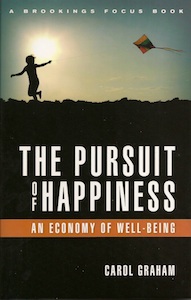
The Pursuit of Happiness book cover
Are wealthy people happier than poor and middle class people? Is a person’s state of happiness a reflection of his or her income? In other words, must income be tied to happiness? What is the relationship between the two? Is it more important to reduce misery or to improve a person’s emotional well being? Is well being tomorrow a good reason to sacrifice happiness today? Everyday people and veteran researchers continue to seek the answers to these questions, especially in the past decade.
This has prompted a burgeoning collaboration between economists and psychologists. Some countries have begun to examine and measure economic happiness issues and address their possible public policy implications. The Brazilian, British and French governments have established programs to measure happiness in relation to their country’s progress. From a big picture perspective this is a novel and controversial approach.
Should nations dedicate resources toward improving their citizens state of contentment or their economic well being? And in making those decisions is it better to focus on tomorrow’s or today’s welfare? Carol Graham, a researcher of “happiness economics” with a decade long track record, examines these issues in The Pursuit of Happiness: An Economy of Well-Being (Brookings Institution Press, $24.95), a 164-page hardcover book published this year.
The book is divided into five chapters: Happiness: A New Science, What We Mean by Happiness: A “Theory” of Agency and Well-Being, Happiness Around the World: What We Know, Adaptation and Other Puzzles, and GNH versus GNP?
Her international research and that of her colleagues has led her to what she calls the paradox of happy peasants and frustrated achievers, she explains in the first chapter. Around the globe she has found that poor people are on average less happy than wealthy people but very poor people often are very happy; poor people often say they are happier than the slightly wealthier among them and even the very rich.
In the absence of abject poverty (and in some cases excess wealth), health concerns, uncertainty, divorce, inflation and unemployment, it seems people across the world are amazingly resilient and adaptable; able to find a constant level of contentment (as defined by them in open ended survey responses), according to Graham.
She indicates that much evidence establishes that happy people are healthier and perform better in the labor market and may have a greater ability to lead purposeful lives than less happy people. Some happiness may be ideal, leading to contentment and purposefulness while too much happiness may lead to complacency, low performance at work.
Graham is a senior fellow in Global Economy and Development and Charles Robinson Chair in Foreign Policy at the Brookings Institution. She is also College Park Professor at the University of Maryland’s School of Public Policy. Her previous books include Happiness around the World: The Paradox of Happy Peasants and Miserable Millionaires, and Happiness and Hardship: Opportunity and Insecurity in New Market Economies.

Click to buy The Pursuit of Happiness
Comments:
Filed Under: Books
Posted by Elena del Valle on September 28, 2011
By Lloyd Chapman
President
American Small Business League
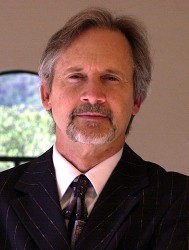
Lloyd Chapman, president, American Small Business League
Photo: American Small Business League
Small businesses are the backbone of the American economy. There are more than 27 million of them and the latest U.S. Census Bureau data tells us that they create 90 percent of all net new jobs. Small businesses are responsible for half the private sector workforce, half of gross domestic product and more than 90 percent of U.S. exports. Also, 98 percent of U.S. companies have less than 100 employees. Yet policymakers either fail to realize this or flat out ignore it. Since 2009, small businesses have received a very small portion of stimulus dollars, while billions have gone to big banks and large corporations.
In 1953 Congress passed the Small Business Act, requiring a percentage of federal contracts to be awarded to small businesses (Currently set at 23 percent). This was a unique approach to economic stimulus. Congress basically decided to use the federal government, being the largest purchaser of goods and services in the world, to stimulate the economy by directing infrastructure spending to the nation’s chief job creators.
Click to read the entire article Small businesses can fix economy if Washington lets them
Posted by Elena del Valle on September 26, 2011

Victor Siegel, CEO, VerveLife
Photo: VerveLife
A podcast interview with Victor Siegel, chief executive officer, VerveLife is available in the Podcast Section of Hispanic Marketing & Public Relations, HispanicMPR.com. During the podcast, he discusses the role of music in a marketing strategy with Elena del Valle, host of the HispanicMPR.com podcast.
Victor recently acquired AppliedSB hoping to create one of the leading technology-driven music marketing firms in the United States. Victor is responsible for all facets of VerveLife’s business operations such as long-term planning, financial management, marketing, product development, creative and acquisition strategy.
The newly-formed organization will be among the first to offer clients a full suite of music marketing strategy, technology and services and a catalog of four million tracks from major labels and significant independents in the United States.
To listen to the interview, scroll down until you see “Podcast” on the right hand side, then select “HMPR Victor Siegel” click on the play button below or download the MP3 file to your iPod or MP3 player to listen on the go, in your car or at home. To download it, click on the arrow of the recording you wish to copy and save it to disk. The podcast will remain listed in the September 2011 section of the podcast archive.
Posted by Elena del Valle on September 23, 2011

It’s Not About You book cover
Photo: Higher Level Group
Bob Burg, sales executive, and John David Mann, who likes to write about business and leadership, co-authored The Go Giver and Go-Givers Sell More in the past. This week, their new book, It’s Not About You: A Little Story About What Matters Most in Business (Portfolio Penguin, $23.95), written as an inspirational fable designed to share wisdom about leadership and subtle influence, was published.
The 144-page softcover book is divided into 14 chapters: The Offer, The Question, The Top Floor, Influence, The Heart of the Operation, The Language of Strength, The Work, Being Muddy, Birth and Death, An Imprint on the Soul, Robbie, Chaos, The Speech, and The Chair; an end section with words of wisdom. An example is of those listed is “The best way to increase your influence is to give it away.”

Click to buy It’s Not About You
Comments:
Filed Under: Books
Posted by Elena del Valle on September 21, 2011
By Neil Tortorella
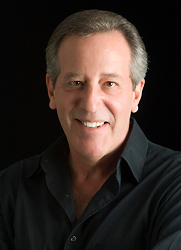
Neil Tortorella
Photo: Courtesy of Neil Tortorella
Press and public relations (P.R.) can be two of the most powerful tools in a business’ marketing toolbox. When managed correctly, they add significant credibility for both the business and its key employees. Plus, p.r. is often less expensive than advertising and can be more believable. From the audience’s point-of-view, a well-placed story, article or interview can be seen as a third party endorsement of the company and/or its leaders.
A public relations program should begin with a simple question – What are you trying to accomplish? When the answer is sharply focused, sensible, strategic and attainable goals can be developed. Just like your business’ overall marketing efforts it all starts with a plan. What steps must you take to get there? Becoming a household name overnight probably isn’t likely, although it can happen. Targeting some local, regional or niche recognition might be a little more achievable.
Click to read the entire article The Potent Power of Press Relations
Posted by Elena del Valle on September 19, 2011
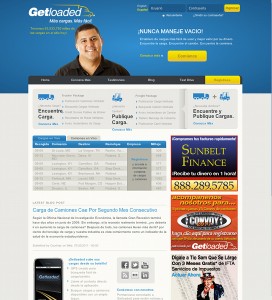
Getloaded.com Spanish language website – click to enlarge
Photos: Formula PR Inc.
In the United States, 8.9 million people are employed in trucking-related jobs; of those nearly 3.5 million are truck drivers, according to Truckinginfo.net, an online portal for the trucking industry established in 1995. The portal’s Trucking Statistics page indicates there are 15.5 million trucks in the United States; one of every nine of the truckers is independent and the majority are owner operators.
Executives at Getloaded, an internet freight matching service, and PM Publicidad Partners, an advertising and marketing services company, believe there are many bilingual and Spanish dominant people among the 370,000 Hispanic truckers nationwide. This past July, they launched Getloaded.com/espanol, a Spanish language version of the main Getloaded website, hoping to capture their attention.
“Getloaded prides itself on innovation and we’re excited to expand our services to include a Spanish-language, cutting edge platform to better support our clients as they seek to grow their business and avoid ‘deadhead’ miles,” said Jon Stier, director of sales and marketing, Getloaded.
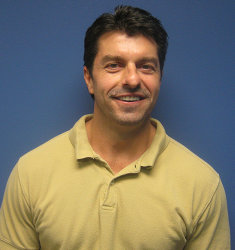
Jon Stier, director of sales and marketing, Getloaded
According to promotional materials, users of the new website will have access to the full functionality of Getloaded, including unlimited load searching and truck posting, freight holder credit scores, immediate notification when loads match their search criteria, and routing and toll information. Ten percent of the employees at Getloaded are Hispanic.
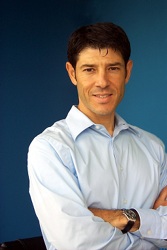
Eduardo Perez, president, PM Publicidad
“From the research results, we have concluded that while the majority of Hispanic truckers are bilingual, they seek and prefer resources in Spanish,” said. Eduardo Perez, president, PM Publicidad. “The project was a transcreation of the English site with the aim to make it relevant for the Hispanic consumer. It was important to us and Getloaded that it wasn’t simply a translation of the English version.”
In making the decision to transcreate all 30 pages of their website into Spanish they relied on the Newport Communication 2005 Latino Truckers Survey which estimated that Hispanics represent approximately 25 percent of the owner and operator trucking segment in the United States. Also, PM Publicidad conducted ethnographic interviews and a quantitative survey to learn more about the profile of the Hispanic trucker.
Posted by Elena del Valle on September 16, 2011
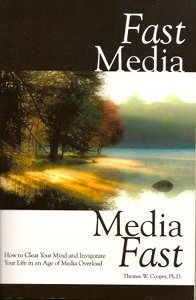
Fast Media, Media Fast book cover
In the United States, the average household consumes eight hours or more a day of television plus web surfing, texting, social media and email, according to a recently published book*. Thomas W. Cooper, Ph.D., a specialist in media and culture, thinks people today rely too much on outside influences they receive from media and marketing messages. He advises reconnecting with others and being aware of media overload. In his most recent book, *Fast Media, Media Fast: How to clear your mind and invigorate your life in an age of media overload* (Gaeta Press, $19.95), published this year, he discusses media responsibility.
The idea, he explains in the Introduction, is to be an active participant instead of a viewer; to be a creator rather than a consumer. By abstaining from consuming media he seeks a rebirth of sorts that may allow him to get in touch with his creative side again. He invites readers to consider the idea of a temporary media fast as he has been doing periodically since 1989. At the end of the fast he, and those readers who follow his example, can choose how much media to introduce back into his life, how often, of what kind, for what purpose and so on.
The 225-page paperback book is divided into ten chapters and four parts: Taking a Personal Media Fast or Diet, Learning from the Fast, Group Fasting and The Ultimate Choice. It also includes two appendices, Personal Fasting and Group Fasting.
Cooper is professor of Visual and Media Arts at Boston’s Emerson College. Before joining the faculty at Emerson, Cooper taught at Harvard University and University of Hawaii. He is also speechwriter for Jochen Zeitz, chief executive officer, Puma. Cooper, a resident of Swampscott, Massachusetts, is the author or co-author of six previous books and one hundred academic and professional articles on media ethics and related topics.

Click to buy Fast Media, Media Fast
Comments:
Filed Under: Books
Posted by Elena del Valle on September 14, 2011

Click to enlarge
Probably produced under the direction of Passchier Grenier, tapestry merchant, c. 1471-1475, wool and silk tapestry, overall: 400 x 1082 cm (157 1/2 x 426 in.), Collegiate Church of Our Lady of the Assumption, Pastrana (Guadalajara). Fundación Carlos de Amberes.
Photos: The National Gallery, Paul M.R. Maeyaert, Dennis Brack/Black Star
The National Gallery of Art in Washington, D.C. is celebrating Hispanic Heritage Month with a series of events that began last week and last through October including The Invention of Glory: Afonso V and the Pastrana Tapestries, a visiting exhibition the result of the collaboration of a number of organizations, as well as several Spanish masterpieces in the Gallery’s collection. The Pastrana Tapestries will remain at the museum from September 18, 2011 through January 8, 2012. The Pastrana Tapestries, considered to be among the finest Gothic tapestries in the world, commemorate the conquest of two strategically located cities in Morocco by the king of Portugal, Afonso V (1432–1481).
The exhibition was organized by the National Gallery and the Fundación Carlos de Amberes, Madrid in association with the embassies of Spain and Portugal, the Spain-USA Foundation, and with the cooperation of the embassies of Belgium and Morocco in Washington, DC, as well as the Diocese of Sigüenza-Guadalajara and the Church of Our Lady of the Assumption, Pastrana, Spain.
From Washington, the Pastrana Tapestries will travel to the Meadows Museum, Dallas, Texas (February 5–May 13, 2012); the San Diego Museum of Art (June 10–September 9, 2012); and the Indianapolis Museum of Art (October 5, 2012–January 6, 2013). The exhibition was made possible through the support of the governments of Spain, Belgium and Portugal.
The conservation of the tapestries, undertaken at the initiative of the Fundación Carlos de Amberes, with support from the Belgian InBev-Baillet Latour Fund, Fundación Caja Madrid, Region of Castilla—La Mancha, Provincial Council of Guadalajara, and Diocese of Sigüenza-Guadalajara and Church of Our Lady of the Assumption, Pastrana, received the European Union Prize for Cultural Heritage/Europa Nostra Awards 2011.
Julia Burke, senior conservator, and Diane Arkin, lecturer, at the Gallery will discuss the Tapestries November 14, 15, 29, and December 6, 8. Sunday, December 18 Barbara von Barghahn, professor of art history, The George Washington University will discuss an Introduction to the Exhibition at the East Building Auditorium.

Click to enlarge
Probably produced under the direction of Passchier Grenier, tapestry merchant, The Conquest of Tangier, (detail) c. 1471-1475, wool and silk tapestry, overall: 400 x 1082 cm (157 1/2 x 426 in.), Collegiate Church of Our Lady of the Assumption, Pastrana (Guadalajara). Fundación Carlos de Amberes.
December 18, at 4 p.m. and Wednesday, December 21 at 12:30 p.m. the Gallery will show Mysteries of Lisbon (Mistérios de Lisboa), a 2010 270-minute film adaption by Raúl Ruiz’s of Portuguese novelist Camilo Castelo Branco’s 1854 romantic epic Mistérios de Lisboa described as a “brilliantly twisting tapestry of interlocking fates and identities” and perhaps the filmmaker’s final work.
During Hispanic Heritage Month gallery talks will include Goya: Portraits of France and Spain, a 30-minute presentation by Giselle Larroque Obermeier October 1 at 2 p.m. in the Rotunda of the West Building Main Floor; and Untitled Composition by Joaquín Torres-García, a 20-minute presentation by Marta Horgan September 22 (12 noon), September 27 (2 p.m.) and October 13 (1 p.m.) in the East Building Concourse Auditorium.
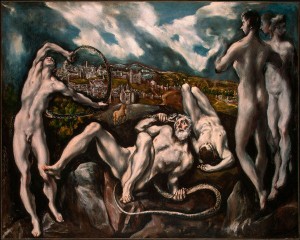
Click to enlarge
El Greco (Domenikos Theotokopoulos), Laocoön, c. 1610/1614, Samuel H. Kress Collection, National Gallery of Art, Washington
Tours of the West Building in Spanish will be offered at 12 p.m. September 15, 17 and October 4, 13, 15 at the West Building Main Floor Rotunda. Tours of the East Building in Spanish will be offered at 2 p.m. September 15, 17 and October 4, 13, 15 at the East Building Ground Level Information Desk. A Spanish Tour of American Art will be available at 12 p.m. September 24 at the West Building Main Floor Rotunda. A self guided tour with 24 stops of The Director’s Tour: Highlights in Spanish will also be available at the West Building Mall Entrance.
The Gallery offers Spanish-language (and other foreign language) guided tours, audio guides, and printed guides to the art collection free of charge and subject to availability. Regular tours of the permanent collection are offered in Spanish as well as in Mandarin, French, German, Italian, Japanese, Korean, Polish, and Russian. Small groups may arrange tours in Dutch, Hebrew, Hungarian, and Portuguese, by calling (202) 842-6247 at least three weeks in advance.

Click to enlarge
View of the West and East Buildings of the National Gallery of Art (1941) looking east towards the U.S. Capitol along Constitution Ave., NW
Guides in Spanish about the Gallery’s permanent collection are available online at nga.gov/collection/ggpdfsp.htm. and a guide containing a brief history of the Gallery, visitor information, and map is available at the information desks and online at www.nga.gov/pdf/map_spanish.pdf.
The Gallery, created for the people of the United States of America by a joint resolution of Congress accepting the gift of Andrew W. Mellon in 1937, has 4.7 million visitors a year. The organization does not gather demographic and ethnic data about visitors. In its collection of 123,000 artifacts displayed in 25,176 square meters of space are masterworks by renowned European and American artists, including the only painting by Leonardo da Vinci in the Western Hemisphere and the largest mobile ever created by Alexander Calder.
Posted by Elena del Valle on September 13, 2011

HispanicMPR.com podcast player
To mark its six anniversary HispanicMPR.com, an online forum and audio podcast for the exchange of information and ideas on business and Hispanic market topics for middle to senior executives, announced the top 25 interview podcasts downloaded in 2010.
The most downloaded podcast interviews of 2010 are, in descending order: Rupa Ranganatan (2007), John Mayerhofer, Laura Hernandez, Michele Valdovinos, Jaime Suchlicki, Ph.D., Matias Perel, Cynthia Nelson, Daniel Ayala, Carlos Santiago and Derene Allen, Derorah Ramirez, Martha Montoya, Liria Barbosa, Jose Reyes, Demian Bellumio, Mabel Valdiviezo, Teresa Iglesias Solomon, Maria Azua, Edna Chun, Ph.D., Carlos Alfaro, Antonio Otalvaro and Noah Otalvaro, Steve Bergsman, Gail Mills, Federico Subervi, Ph.D. and Diana Rios, Ph.D., Cynthia Hudson, and Kathleen Haley.
A comprehensive list of podcast guests beginning in 2006 may be found at https://www.hispanicmpr.com/podcast-list/
Started as a weblog for the Hispanic Marketing & Public Relations book (Poyeen Publishing, $49.95), HispanicMPR.com provides news and information and expert audio interviews. Visitors may sign up for regular email updates, search the website for Hispanic market information; and listen to podcasts on the website’s audio player or download them to their MP3 or iPod players. More information on HispanicMPR.com is available online at https://www.hispanicmpr.com
Posted by Elena del Valle on September 13, 2011
Information provided by Event Partner

25th Annual NAMIC Conference
New Media, New Voices, New World
October 4-5, 2011, Hilton New York
Demographic shifts, multi-screen platforms, social media – it’s a new day filled with powerful anticipation of the next big thing. Today, the ecosystem of the digital world is a confluence of interactive, multi-cultural, multi-faceted, multi-tiered, multi-everything that is generating a new idea every New York minute. The NAMIC 25th Annual Conference fulfills the promise of 25 years of content excellence with dynamic presentations and interactive sessions delivered by the experts – new and seasoned pros – who are embracing the sparkling evolution of an industry of inevitable breakthroughs. Don’t miss it! Register now at www.namic.com



























